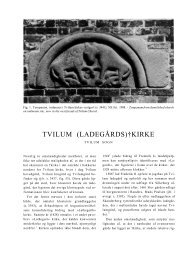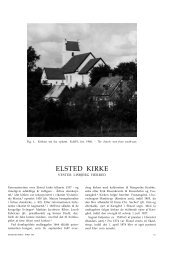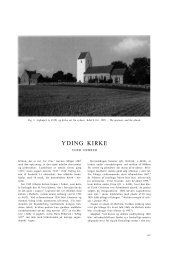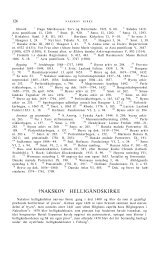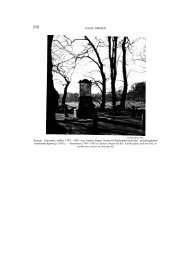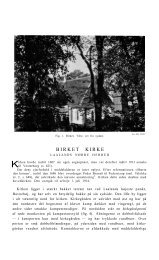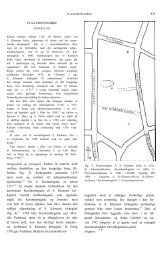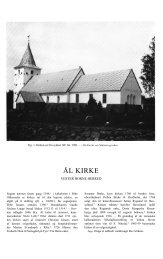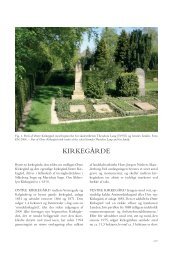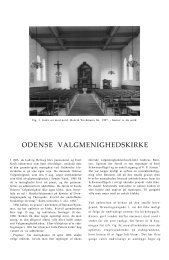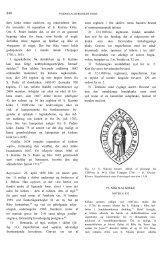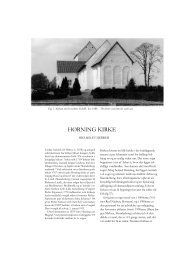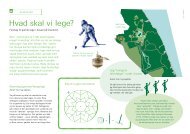†SORTEBRØDRE KLOSTERKIRKE
†SORTEBRØDRE KLOSTERKIRKE
†SORTEBRØDRE KLOSTERKIRKE
Create successful ePaper yourself
Turn your PDF publications into a flip-book with our unique Google optimized e-Paper software.
<strong>†SORTEBRØDRE</strong> <strong>KLOSTERKIRKE</strong> 1767<br />
kisten, idet det friholdte - eller sekundært tømte - hul<br />
i konstruktionen var af en størrelse, der kun vanskeligt<br />
tillod efterfølgende nedsættelse af en kiste.<br />
77 Gravnr. SBT81-G12.<br />
78 Gravnr. SBT81-G598.<br />
79 Gravnr. SBT81-G607.<br />
80 Umiddelbart syd for kormuren; på området, inddraget<br />
til kirkens udvidelse mod syd.<br />
81 Gravnr. SBT81-G563.<br />
82 Gravnr. SBT81-G622.<br />
83 Gravnr. SBT79-G30 og SBT79-G31.<br />
84 Gravnr. SBT81-G50, SBT81-G66, SBT81-G73 og<br />
SBT81-G177.<br />
85 Gravnr. SBT81-G463.<br />
86 Gravnr. SBT81-G637.<br />
87 Nr. SBT81-K41. Dateringen af gruben er usikker;<br />
der angives at være fundet et stjertpotteskår i gruben,<br />
hvilket antyder, at den kan være omtrent samtidig<br />
med kirkens nedrivning. 1981 fremkom yderligere<br />
to, om end mindre gruber med skeletdele.<br />
88 Møntergården, inv.nr. SBT81-G382-1<br />
89 Møntergården, inv.nr. SBT81-GF-1.<br />
90 Seglet er i Odense bys historie 1, 222 forsøgsvis identificeret<br />
med en Johannes Bjørnsen, muligvis af slægten<br />
Laxmand; dette er, jfr. meddelelse ved Knud<br />
Prange, næppe sandsynligt. Ligeledes synes seglet<br />
ikke at være identisk med Henry Petersen, Danske<br />
Adelige Sigiller fra det XIII og XIV Aarhundrede, Kbh.<br />
1897, nr. 236, idet den her nævnte Johannes Bjørnsen<br />
tilsyneladende bærer en takket murkrone i sit<br />
skjold.<br />
91 Møntergården, inv.nr. SBT79-E8-G29-1.<br />
92 Møntergården, inv.nr. SBT81-G644.<br />
93 Møntergården, inv.nr. SBT81-G618.<br />
94 Møntergården, inv.nr. SBT81-C4-G621.<br />
95 Møntergården, inv.nr. SBT79-K22-G20-1.<br />
96 Møntergården, inv.nr. SBT81-208906,<br />
90/107433,52.<br />
97 Keld Grinder-Hansen, »Dødemønter fra danske<br />
kirker og kirkegårde«, hikuin 17, 1990, 150.<br />
†BLACKFRIARS MONASTERY CHURCH<br />
ENGLISH SUMMARY<br />
HISTORICAL BACKGROUND. The provincial<br />
chapter was held by the Dominican order in<br />
1252 in Odense. This is the first mention of the<br />
Blackfriars in Odense, and it must presuppose<br />
that the order was at the time firmly established<br />
although the founding date of the monastery is<br />
not known precisely. The monastery was presumably<br />
consecrated to St. Peter; in any event<br />
St. Peter's cemetery is mentioned in 1478.<br />
From 1291 onwards innumerable bequests<br />
and other gifts are on record. In 1316 the Dominicans<br />
together with the Franciscans in<br />
Odense were granted permission to hear confession,<br />
hold divine service and sell indulgences in<br />
St. Knud's Church: circumstances which must<br />
have increased their chances of making an income.<br />
The Dominican monastery received a letter<br />
of indulgence in 1400. The priory buildings<br />
must have been of some size, since in 1375 court<br />
proceedings were held in the house belonging to<br />
the preaching friars, and in 1426 in the sacristy<br />
of the church. However, this is unlikely to have<br />
been so in the case of many conventions and<br />
court proceedings held in the Dominican chambers<br />
during the 15th and beginning of the 16th<br />
century. The fact that both the diocesan conference<br />
- and in 1501 the assembly - took place at<br />
the monastery is testimony to its prominence. It<br />
is mentioned in 1504 that King Hans passed numerous<br />
judgements in his council chamber at<br />
the Dominican monastery in Odense.<br />
The monastery was dissolved upon the Reformation,<br />
and handed over to Greyfriars hospital<br />
in 1540. The church was to be demolished<br />
and the other buildings were to serve as living<br />
accommodation. In 1555 the burghers of<br />
Odense were granted permission to use the<br />
Blackfriars cemetery for interments. For how<br />
long it remained in use is not known, but it<br />
appears from a letter patent in 1607 to be no<br />
longer in use. In this instruction the King gives<br />
permission for an old stone-built house in the<br />
cemetery to be demolished. A record in 1788<br />
mentions a mortuary in the Blackfriars ceme-




